Acknowledgments
Without the assistance and cooperation of many individuals and institutions, this work would not have been possible. We acknowledge the help of several individuals, including Donald Albro, Harold Allen, Ronald Barney, Rick Boomgarden, Greg Christofferson, Gary Cottle, Michaela Voss Cottle, Larry Draper, Tyler Edmundsen, David Ettinger, Chad Flake, Jeni Broberg Holzapfel, D. J. Isom, Edith Menna, Melissa Ostler, Lee Pement, Ronald Read, Margaret Rich, Ronald Romig, Dana Roper, Roseline Seaver, Elbert Sheppard, R. Q. Shupe, William Slaughter, Steven Sorensen, Eldred G. Smith, Ted D. Stoddard, Richard Turley, and Alan Wood. We express gratitude also to our publisher, Bookcraft, Inc., who considered our proposal a valuable project-in particular, we thank Jana Erickson and Cinda Morgan for their extra efforts in the design and layout of the book.
Several institutions and the Eldred G. Smith family have graciously provided copies of photographs, access to artifacts within their collections, and permission to reproduce them. We thank the Archives Division, Church Historical Department, The Church of Jesus Christ of Latter-day Saints, Salt Lake City, Utah; Archives-Library, Missouri Historical Society, St. Louis, Missouri; British Museum, London, England; Cincinnati Public Library, Cincinnati, Ohio; Detroit Institute of the Arts, Detroit, Michigan; George Eastman House, International Museum of Photography, Rochester, New York; Illinois State Historical Library, Springfield, Illinois; Library-Archives and Museum, Reorganized Church of Jesus Christ of Latter Day Saints, Independence, Missouri; Library of Congress, Washington, D.C.; Manuscript Department, Special Collections, and Photoarchives, Harold B. Lee Library, Brigham Young University, Provo, Utah; Mariners Museum, Newport News, Virginia; Missouri State Historical Society, Columbia, Missouri; Museum of Church History and Art, The Church of Jesus Christ of Latter-day Saints, Salt Lake City, Utah; National Maritime Museum, Greenwich, England; National Society Daughters of Utah Pioneers Memorial Museum, Salt Lake City, Utah; Nauvoo Historical Society, Nauvoo, Illinois; Restoration Trails Foundation, Independence, Missouri; Special Collections, J. Willard Marriott Library, University of Utah, Salt Lake City, Utah; Smithsonian Institute, Washington, D.C.; Visual Resources Library, The Church of Jesus Christ of Latter-day Saints, Salt Lake City, Utah; Western Reserve Historical Society, Cleveland, Ohio; and the staffs at the Joseph Smith Historic Center, the LDS Visitors' Center, and Nauvoo Restoration, Inc., in Nauvoo, Illinois.
Introduction
As we consider the rich heritage we have received as Latter-day Saints and the faith and sacrifice of those who have gone before us, there is no question that the Lord blessed the early Saints of this dispensation, who were given "power to lay the foundation of this church, and to bring it forth out of obscurity and out of darkness" (D&C 1:30). Since its organization on 6 April 1830, The Church of Jesus Christ of Latter-day Saints has attracted a great host of converts and received much attention from the general public. In 1852, Charles Mackay, an English author, published a small engraved work that he claimed was the first public history of "that new religion" founded in America by Joseph Smith, Jr. (1805-1844), "one of the most remarkable persons who has appeared on the stage of the world in modern times" (The Mormons, or Latter-day Saints [London: Office of National Illustrated Library, 1852], p. iv). While it is certain that Mackay was not the first to write a public history of the Latter-day Saints, he was undoubtedly correct when he stated that Joseph Smith was a remarkable person. The Saints agree that their Prophet was an exceptional and inspired leader, but both Latter-day Saint and non-Latter-day Saint historians have also generally recognized that the church he founded and the converts to it were also extraordinary. Clearly this history is worth retelling to each succeeding generation.
Since the book of scripture known as the Doctrine and Covenants is intimately tied to the early history of the restored Church, our work draws many of its themes and topics from the text of this modern witness of Christ. The 1981 edition of the Doctrine and Covenants contains 138 sections and 2 official declarations. Of these, 133 were received principally through the Prophet Joseph Smith. The 7 remaining sections and declarations were received or recorded by or under the direction of Oliver Cowdery, John Taylor, Brigham Young, Joseph F. Smith, Wilford Woodruff, and Spencer W. Kimball (see D&C 102, 134, 135, 136, 138, Official Declarations 1 and 2).
These important revelations, commandments, letters, prayers, and inspired writings are recognized by the Latter-day Saints as "the will of the Lord, the mind of the Lord, the word of the Lord, the voice of the Lord, and the power of God unto salvation" (D&C 64:4). Through the pages of the Doctrine and Covenants, the world of the dedicated women and men of the Church is uncovered as they attempted to understand their personal missions, especially as those missions related to the coming forth of the kingdom of God in the latter days.
This book is an attempt to reveal our common Latter-day Saint history in a new and exciting way. It does not follow the customary method of describing the story based on a strictly chronological review of dates, names, and places. It uses material culture-artifacts-as a means of visualizing social settings. Material culture research is both an old and a new discipline in the United States, yet it still has not won a wide following among historians. While the definition of the term material culture is debated among scholars, we use the term to mean "artifacts." (See Thomas J. Schlereth, "Material Culture and Cultural Research," in Material Culture: A Research Guide, ed. Thomas J. Schlereth [Lawrence: University Press of Kansas, 1985], pp. 3-7.)
Traditionally, historians of the Church have not used artifacts as evidence in their research. Few of them have examined carefully the triptych of human necessities-clothing, food, and shelter. (An exception is the recently completed work of Carma de Jong Anderson, "A Historical Overview of the Mormons and Their Clothing, 1840-1850" [Ph.D. diss., Brigham Young University, 1992].) Artifacts of the past, nevertheless, have become important evidences in the documentation and interpretation of the American experience in the broader field of American history. John Demos's pioneering study A Little Commonwealth: Family Life in Plymouth Colony (New York: Oxford University Press, 1970) examines the colonial family of Plymouth in a specific American context. In the absence of the usual literary sources, Demos centered his research on domestic shelter and artifacts of the seventeenth-century Pilgrim community.
Like most Americans of the period, a large segment of the early Latter-day Saint membership left few literary records. For the majority of people, the primary historical record of their lives is not written but survives as data gathered about them or, as happens even more frequently, as objects made and used and finally discarded by them.
This study, then, begins to collect and reproduce the artifacts of the Restoration, gathered from sources associated with both The Church of Jesus Christ of Latter-day Saints (LDS) and the Reorganized Church of Jesus Christ of Latter Day Saints (RLDS). Many historical studies relating to the history of the restored Church, like the broader field of American history, tend to be written for fellow academic specialists or for a narrow group of university-educated and well-read members of the Church. Material culturists, on the other hand, have usually worked in a more diverse and decentralized institutional structure composed of museums, government agencies like the National Park Service, and state historical societies. Institution staff members at the Museum of Church History and Art (LDS), Restoration Trails Foundation (RLDS), Nauvoo Restoration, Inc. (LDS), and the RLDS Museum Department have all made contributions in the area of understanding material culture. In this connection, it is interesting to note a statement from Thomas J. Schlereth, graduate director of the American Studies Department at the University of Notre Dame: "It must be acknowledged that material culture studies, despite all the methodological creativity demonstrated by some of its most pioneering proponents, are still only beginning to explore the conceptual and analytical potential of this approach to historical study" (
Next page














